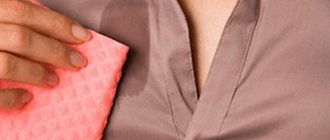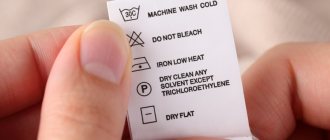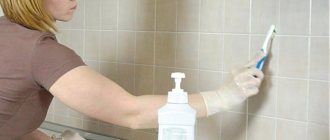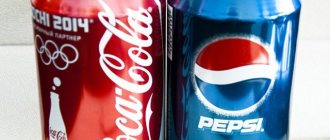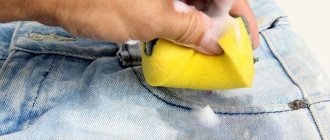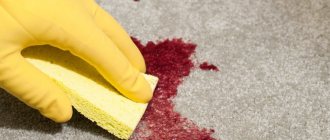The bathroom is a pleasant place to stay, where you always want to keep it clean and fresh. In order for everything to be exactly like this, it is necessary to treat the surface layer every time, remove limescale and stains of various kinds.
But before you get to work, you should definitely familiarize yourself with some of the nuances of processing a particular surface.
Today, shops and markets are overflowing with products that are the main element of the bathroom. The bathtub can be enameled or made of cast iron. Acrylic bathtubs are also very popular. And all such important elements should simply shine, and not overshadow with their appearance.
Initial and useful recommendations for caring for your bathroom:
- Strong chemicals (such as acid) should not be used because they can destroy the enamel or damage the surface layer with their concentration.
- Be sure to wear rubber gloves before starting work.
- You should not clean the surface with rough (metal) brushes, because the first time it may be possible to clean the rough spots, but the second time it will definitely not work. After all, the surface layer will be scratched and rust or limescale will penetrate deeply into these scratches, and then it will be almost impossible to clean such a surface.
- After each use of water procedures, it is necessary to rinse the surface of the bath with plain water.
- If you have bath curtains, you should definitely disinfect and dry them, because it is from them that yellowness and difficult-to-remove stains can appear, not to mention mold and mildew.
Baking Soda, Vinegar and Bleach
Frequent contact with water gradually leads to contamination, which must be dealt with. You can clean the bathtub with soda and vinegar, especially since every kitchen has such products. The work will need to be carried out in several stages.
First, apply a layer of soda, which is a known absorbent, and leave it for at least half an hour. During this time, limescale deposits and ingrained dirt are corroded. Vinegar and bleach are mixed in equal proportions and this mixture is applied on top of the soda and left for half an hour.
After which, with the help of a sponge and a shower, all layers are removed, and you can immediately see how the bath not only acquires a clean look, but also whitens. This method is great for enamel baths. Moreover, the surface is washed even from yellow stains.
If the bathtub is not very dirty and the dirt is superficial, you can use only 9% vinegar. To do this, a foam sponge is moistened with the solution and left overnight, after which it is washed off with running water. This option is ideal for a cast iron bathtub.
Rules for washing white clothes
In order for white things to remain snow-white for as long as possible, it is necessary to follow certain rules for washing them:
It is important to sort laundry correctly. Under no circumstances should you wash colored, dark and light colored items together.
Otherwise they will shed. In addition, the type of fabric must be taken into account. Clothes made from natural materials, silk, and synthetics should be washed at different temperatures. The choice of detergent should also depend on the type of fabric. For example, chlorine bleach can only be used on cotton or linen items. In other cases, it is recommended to use more delicate means. Do not use bleach to clean jeans to prevent the material from turning yellow. It is advisable to add fabric softener or a special softener to the powder or bleach. This neutralizes the negative effects of hard water. After washing, things will smell good and become pleasant to the touch. Before you start bleaching, it is advisable to clean the item from dust and other dirt. Otherwise, dirt may be absorbed deeper into the fibers of the fabric, and stains will remain on the material. If white clothes become difficult to wash in an automatic machine, you should clean the device. Perhaps dirt has accumulated in the rubber seal, or the heating element is covered with scale. In addition, the drain filter could be clogged, which prevents proper rinsing of the laundry. In this case, you need to wipe the insides of the machine with a clean rag, paying special attention to the rubber seal and the powder tray
Grease stains and sweat stains can be removed by applying a little dishwashing detergent to the dirty areas. It is left for 20-30 minutes and then washed in the usual way.
Regular aspirin will also be a good help in the fight against yellow sweat spots. You will need to crush 3-4 tablets into powder and dilute them with water to a paste. The resulting mixture is applied to problem areas and washed off after 30-40 minutes.
Lemon acid
As practice shows, citric acid is the first enemy for yellow spots and lime deposits. For enamel baths, this is a completely safe method, and even if any stains remain after cleaning with citric acid, they can be easily removed with soda.
When using lemon juice, you need to make a concentrated solution (2 tablespoons of acid crystals per glass of water). Then put on rubber gloves and, moistening the sponge in the solution, rub the surface of the bath. You can leave it like this overnight or for several hours. Then rinse everything off with plain water and wipe with a dry cloth. Moreover, even rust is removed in this way.
Preliminary preparation
Proper preparation of things is half the success in the difficult fight against dirt. They can be presented as the following list:
- Don't hoard laundry for a long time. During this time, the stains have time to dry and become deeply embedded in the dirt.
- Completely fresh dirt cannot be vigorously scrubbed, as this will lead to the opposite effect: on the contrary, it will eat deeper and deeper, in direct proportion to the effort applied.
- The effectiveness of washing depends on the quality of the water: in soft water, stains literally dissolve on their own; in hard water, they are almost impossible to wash off. Finding out what kind of water is in the tap is easy. First, the soap is grated or shaved with a knife. Then a small amount of shavings is added to a container with warm water and stirred. In soft soap, the soap will dissolve quickly, but the liquid will be clear. In hard water the process will take longer. In this case, a film will appear on the surface. To soften, it is advisable to add 2 tbsp. l. soda into the washing or rinsing water.
- Soaking and pre-washing significantly improves the quality of the entire wash. White items can be left in soapy water overnight, colored items for no more than 3 hours.
- It is recommended to soak handkerchiefs in strongly salted water for several hours, and only then start washing.
- Before machine washing, you can treat stains with a mixture of mustard and water. And you need to put things away without washing off the product.
The appearance of limescale
The hardest thing is to clean the bathtub from ingrained dirt and limescale. You can choose several methods for cleaning, but at the same time, you need to take into account what material the bathtub is made of.
- You can get rid of old plaque by using a mixture of vinegar and salt. They dilute 1:1 and often apply several layers alternately, because one cleaning is not enough and the bathtub still remains dirty. The result after the work will exceed all expectations, but you will have to work hard. The solution is not simply moistened with the surface, but rubbed in in a circular motion to thoroughly wet all contaminated pores. Vinegar will give the bath whiteness and shine.
- You can use ammonia diluted in water. Proportion 3:1. Clean off the accumulated plaque and leave for half an hour. After this, rinse off and wipe dry.
General Tips
For housewives, the question of how to remove dirt stains is one of the most pressing. In fact, there are a lot of ways. Each woman chooses what she considers the most effective and suitable:
- You can add a few spoons of the following mixture to the washing powder: grated soap, borax and soda in a ratio of 2:1:1. You can mix the ingredients in advance and store the product in a jar or well-closed box and use it as needed. Some housewives use it instead of powder.
- You can add 100 ml of wine vinegar to the rinse water. It will wash the soap and also act as a fabric softener: it will make it soft.
- Clothing made from natural fabrics (cotton and linen) can be washed well using soda ash. When machine washing, it must be added directly to the drum. Items should be washed at a temperature no higher than 70 degrees. It is not recommended to wash silk and wool with soda, as the material becomes hard.
- A small amount of potassium permanganate is diluted in hot water (10 l) so that the liquid becomes slightly pink. Then add 200 ml of soap solution there. Place washed laundry into the mixture and leave it overnight. Then the things are rinsed well.
- You can add citric acid to light-colored items when machine washing; it has a bleaching effect. A packet of dry yeast has a similar effect.
- You can add a little baking soda to the drum. This will soften the water and make the laundry much cleaner.
- Hold contaminated clothing over boiling water with lemon juice.
Acrylic bath
Today, acrylic bathtubs are popular elements of the bathroom, but, unfortunately, such material cannot withstand aggressive chemicals, because when used, the bathtub quickly becomes unusable. Based on this, before you begin to remove contaminants, you need to select a safe product for such material.
You should definitely exclude alcohol-containing products, as well as ammonia and various types of acids. If you use washing powder, of any brand, the bathtub will certainly acquire a yellow color that you will not be able to get rid of! Therefore, it is necessary to be extremely careful.
It is best to care for an acrylic bathtub using liquid soap and wax polish. After taking a shower, moisten a foam sponge with liquid soap and rinse the surface of the bath. Next, wash off with water. To maintain the shine and whiteness of acrylic for a long time, rub it with wax polish at least several times a week. That’s when the bath will always be white and its appearance perfect!
The best stain removers for white clothes
White products contain bleaches to maintain or restore the color of fabrics.
Such stain removers can be used to remove stains of various origins or sometimes added to washing powder to remove a yellowish or grayish tint on old clothes.
Clean Home Express effect
4.9
★★★★★ editorial assessment
87% of buyers recommend this product
Clean Home Express effect is a dry bleach with an environmentally friendly composition. It is suitable for all types of fabrics, including delicates and woolen items. The stain remover does not contain aggressive components - it is effective due to the active oxygen in the composition.
The product performs well in removing old stains from drinks and food, blood, ink and chemical dyes. It can be used to remove stains before the main wash or poured into the machine along with powder to enhance the effect.
The powder is supplied in 1 kg plastic buckets with a sealed lid and a measuring spoon inside. According to the manufacturer, one such package is enough for 125 kg of laundry. When dry, the product has a light aroma, but the smell does not remain on things.
Pros:
- does not contain chlorine and phosphates;
- does not smell;
- there is a measuring spoon;
- economical consumption;
- convenient packaging.
Minuses:
does not work at low temperatures.
The manufacturer claims that the powder is effective in cold water. Housewives recommend the product, first of all, as a supplement to powder when washing in water no colder than 40 degrees.
Frosch
4.7
★★★★★ editorial assessment
84% of buyers recommend this product
German stain remover Frosch is designed for application to stains before the main wash cycle. It contains no chlorine, the main active ingredient is citrate salt of citric acid. Thanks to this, the product is safe for all types of fabric and suitable for children's clothes.
The stain remover is sold in a 75 ml plastic tube. It is applied using a foam tip, which ensures deep penetration of the formula into the fabric with minimal consumption.
Pros:
- unexpressed citrus aroma;
- copes well with stains;
- environmentally friendly composition without chlorine;
- ease of use;
- can be used for children's clothing.
Minuses:
- Sold only in small 75 ml bottles;
- difficult to wash.
The product is designed for washing white clothes, but buyers assure that it can also be used with most colored fabrics. Thanks to its gentle composition, the stain remover will not spoil bright clothes.
Vanish Gold Oxi Action “Crystal White”
4.7
★★★★★ editorial assessment
73% of buyers recommend this product
See review
Vanish Gold Oxi Action powder stain remover for white clothes is one of the most advertised products. The manufacturer promises to remove any stain within 30 seconds and lighten the fabric by 3 tones.
This bleach is used in different ways: in paste form for application to an old stain, diluted for pre-soaking clothes, and also as a detergent enhancer.
Housewives confirm the declared quality and recommend combining all methods of use to clean the most stubborn stains, as well as washing white items with Vanish at a temperature of 60-90 degrees to obtain maximum effect.
Among the active substances of the product are surfactants, active oxygen and enzymes. There are no phosphates or chlorine in the composition, which means that the stain remover does not spoil the structure of the fabric fibers. The powder is sold in plastic buckets with a screw-on lid of 90, 250, 500 or 1000 g.
Pros:
- convenient packaging;
- can be bought in almost every store;
- measuring spoon included;
- copes with various contaminants;
- does not contain chlorine and phosphates;
- removes yellowness and grayness.
Minuses:
- not suitable for wool, silk and leather;
- Strong smell.
Before use, it is recommended to test the product on an inconspicuous area of clothing.
Enamel bath
Although an enamel bath is considered wear-resistant, exposure to strong acids and concentrated chlorine can quickly remove the shine of the surface layer. Of course, when cleaning, you cannot use metal brushes, which will scratch the enamel, and over time it will deteriorate.
If strong stains of rust or limescale have appeared and cannot be removed by anything, then you can resort to hydrochloric acid. Soak a foam sponge in the solution and rub the areas where dirt appears. Leave for 15 minutes, then rinse with water. In this case, the solution must not come into contact with the chrome elements of the product!
Stain removal - features
Each type of fabric has its own specifics. You have to take it into account if you value time and effort, and also have a desire to save the dirty item.
Cotton
This material is natural, lightweight and has good breathability. At the same time, it easily wrinkles, loses its shape, and white things turn yellow over time.
Cotton fibers are not strong - they fray easily, and therefore it is advisable to clean such textiles from the wrong side.
Stains on clothes are mainly left by:
- drinks (red wine, tea, coffee, juices, etc.);
- cosmetics (lipstick, mascara, eye shadow);
- blood and sweat;
- grass;
- paints, etc.
It is most difficult to remove stains from knitted cotton products (T-shirts, tank tops, etc.). The trouble is that this type of textile stretches easily, causing the fibers to fray and form unsightly pellets. To avoid trouble, do not rub the problem area.
Dip a cotton pad (or a small white piece of paper) into the appropriate mixture and gently blot the stain until it disappears.
Tip: after washing, rinse new wardrobe items in a vinegar solution (1 tablespoon per liter of water) - this will make the fabric softer and further disinfect it.
Synthetics
When removing contamination from these types of textiles, you need to remember several rules. In particular, these products cannot:
- clean with products containing acetone;
- wash in water whose temperature is above +60 °C;
- iron with too hot an iron (more than +200 °C).
Prints are also prohibited from rubbing with any aggressive compounds.
Leather
When starting to remove stains from things made from this material, you must first find out several important points:
- make sure that we are talking about leather and not a substitute;
- determine how stable the dye is;
- Find out what exactly caused the stain.
All this will allow you to choose the most effective remedy and avoid most annoying mistakes. You can read in detail how to clean a leather jacket from stains on our website.
Remember, only the best leather, tinted with high-quality pigments, can survive contact with substances such as:
- turpentine;
- acetone;
- alcohol;
- gasoline, etc.
Jeans
The first thing you should always remember is that items made from the specified material must be sent to dry immediately after washing.
If an item is left in the machine, a number of risks arise:
- rivets may rust and show marks on the fabric;
- leather labels - fade onto jeans;
- the paint used to treat the textile will flow.
It is important not to rub stains with water. This is completely meaningless if they were formed by fat. This will only make the situation worse.
Jeans cannot be washed until local stains have been removed - this is the main condition. Processing is carried out as follows:
- Place the item turned inside out on a flat surface covered with 5-6 paper towels;
- use only a clean cloth to remove stains;
- upon completion of work, soak the item for 1-2 hours in water with powder;
- then wash as convenient.
Remember - the sooner you start, the greater the chance of success, because old dirt often does not respond to any methods.
Hydrogen peroxide and ammonia
In a liter jar, mix 150 milligrams and 50 grams of hydrogen peroxide and leave for 15 minutes to obtain a reaction. Next, using a foam sponge soaked in the resulting solution, rub the surface of the bath, especially in places of heavy contamination. Leave for half an hour and then rinse with running water.
Cleaning the bathtub with folk remedies always helps housewives to keep the room clean, and this method returns the former shine and whiteness of the bathroom surface. This method is ideal even for cleaning the oldest bathtub with stubborn dirt.
Mold
Chlorine-containing liquids, which are applied to the surface with a sponge, will help get rid of mold in the bathroom. An ideal option for getting rid of fungus is tea tree oil. A few tablespoons of oil are dissolved in water and the surface is treated. After this, leave for 12 hours for thorough, complete processing.
Brown mold is easily removed. For 3 liters of water you need to use a glass of borax. The resulting composition is applied to the surface and does not even need to be rinsed off. You just need to wipe the bath with dry paper.
How to remove dirt from a jacket
If stains appear on a white jacket, they must be removed as quickly as possible. After all, over time, dirt can be firmly absorbed into the fibers.
Removing traces of dirt from a jacket has several aspects:
- First of all, you need to remove any grease or other substance with a wet cloth.
- Apply cleaning agent to the fabric. It must first be tested on an inconspicuous part of the product.
- Stains should be rubbed, moving from the edges to the center, so as not to increase the dirty mark.
- Next, the jacket must be placed in the machine. If a very powerful substance was applied, it should be rinsed in cold water before machine washing.
- Before placing the jacket in the drum, it is recommended to thoroughly wash the collar and cuff area.
Before fully washing any item, it is first recommended to study the label and be sure to turn the item inside out.
Household chemicals
Of course, you can fight bathroom pollution not only with the help of folk remedies. At the moment, there are a lot of developed solutions of household chemicals. You just need to carefully read why and how to use this or that product.
Cleaning the bathroom is not only about cleaning the bathtub from stains and all kinds of dirt. After all, first of all, such disinfection is safe for health, because almost any chemical substances help fight the growth of bacteria, fungus and mold.
How do you like the article?
Tough stains
If untidy marks on clothes are discovered late, it will be much more difficult to wash them and you will have to put in more effort. Such contaminants are called difficult to remove. Sometimes you have to use strong bleaches to eliminate them, and in some cases only proven folk remedies help, because you don’t want to throw away your favorite things.
There are several types of stains that are very difficult to wash off. This category includes stains from:
- sweat;
- food;
- herbs;
- cosmetics;
- paints;
- blood.
Difficult to remove food stains can be divided into several categories. These are untidy blots from vegetables or fruits, drinks, fatty meat dishes. This also includes any derivative products:
- coffee;
- wine;
- sauce;
- jam;
- ketchup;
- jam;
- juice.
Food stains are easily removed at the very beginning. The more time passes from the moment they appear, the more difficult it will be to clean things up. Before choosing a method to eliminate the problem, you need to determine the type of fabric, the type of stain and the period during which the stains remained on the clothing. After studying the product label, it will be clear what types of processing are acceptable.
- 5 places where you can relax in Russia in summer 2020
- Hiccups in newborns
- Pancakes without eggs


